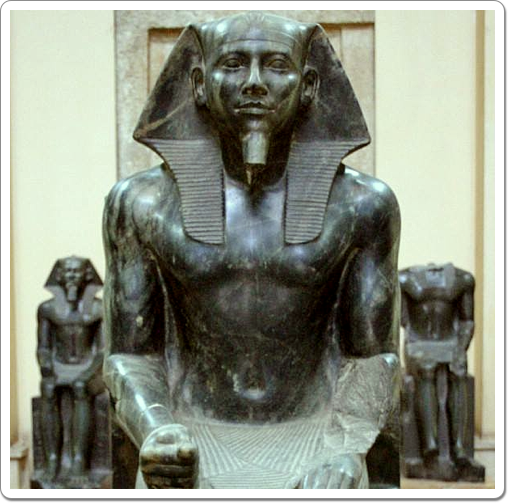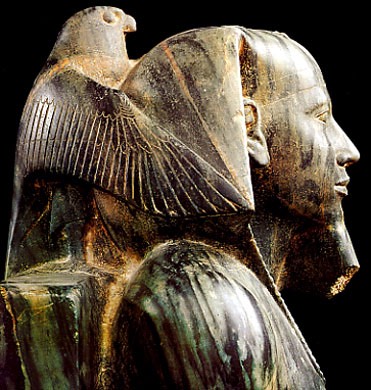This 168cm high diorite statue, found in 1860 in the Valley Temple of Khefren's funerary complex at Giza by the French archaeologist Auguste Mariette, represents Khefren, seated on an elaborate throne. It is one of many examples of high craftsmanship from the Old Kingdom.

Khefren’s most famous statue represents him seated on a his throne, protected by the god Horus.
Source: Egyptian Antiquities on Facebook
Even though the throne was made of one block of massive diorite, its legs are carved to resemble the paws of lions, whose heads decorate the front of the seat.
The sema-tawi symbol between the legs of Khefren's throne.
Source: Schultz - Seidl e.a., Egypte. Het land van de farao's, p. 67.
The side panels of the throne carry the so-called sema-tawi symbol: the heraldic plants of Upper and Lower Egypt tied together in a knot around a hieroglyph representing the notion 'unity'. The sema-tawi symbol thus represents the unity between Upper and Lower Egypt and would be featured on thrones of kings throughout the Ancient Egyptian history.
Seated regally on his throne, Khefren wears the nemes headdress adorned with a (damaged) uraeus His eyes are narrow, the nose prominent and the mouth full. His round face emanates power and authority. His beard, another sign of his royalty, is chipped at the bottom.
A falcon, symbol of the god of the divine kingship, Horus, sits on the back of the throne and spreads its wings in a protective gesture around the head of the king.
The king wears a traditional skirt. His left hand is stretched out and lying on his leg. His right hand is cleched into a fist, in which he holds a cloth. His arms are very muscled and strong. His left arm and leg are slightly damaged.
This statue was found in a pit in the king's Valley Temple. It probably once stood in this temple, along with several other statues which have been found there and is likely to have served in the mortuary cult of Khefren.
